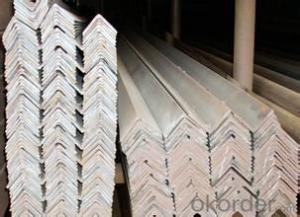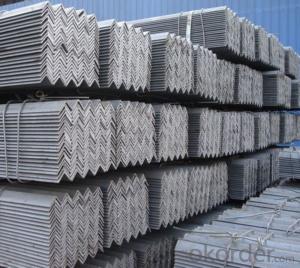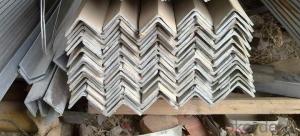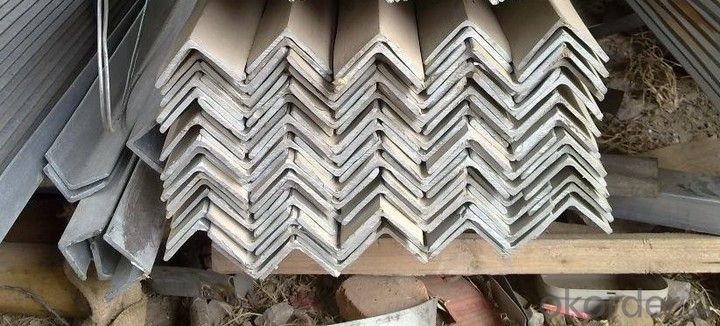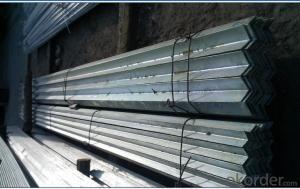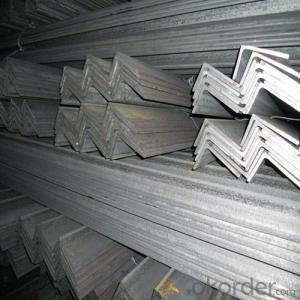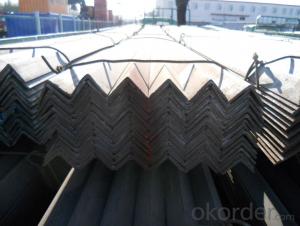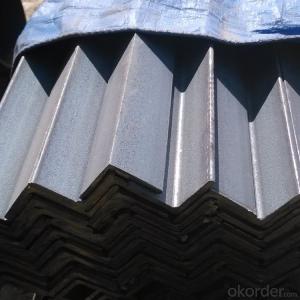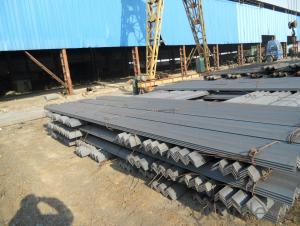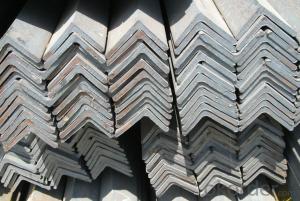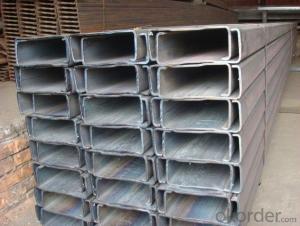DIN1028 galvanized angle steel for construction
- Loading Port:
- Tianjin
- Payment Terms:
- TT OR LC
- Min Order Qty:
- 25 m.t.
- Supply Capability:
- 10000 m.t./month
OKorder Service Pledge
OKorder Financial Service
You Might Also Like
Product Description:
Specifications of Equal Angle Steel
1.Standards: GB
2.Material: GBQ345 or Equivalent
3.Length: 6m, 12m
4. Size:
| Size (mm) | Mass (mm) | Size (mm) | Mass (mm) |
| 100*100*6 | 9.366 | 100*100*10 | 15.120 |
| 100*100*7 | 10.830 | 100*100*12 | 17.898 |
| 100*100*8 | 12.276 |
Usage & Applications of Equal Anlge Steel
Trusses;
Transmission towers;
Telecommunication towers;
Bracing for general structures;
Stiffeners in structural use.
Packaging & Delivery of Equal Angle Steel
1. Transportation: the goods are delivered by truck from mill to loading port, the maximum quantity can be loaded is around 40MTs by each truck. If the order quantity cannot reach the full truck loaded, the transportation cost per ton will be little higher than full load.
2. With bundles and load in 20 feet/40 feet container, or by bulk cargo, also we could do as customer's request.
3. Marks:
Color mark: There will be color marking on both end of the bundle for the cargo delivered by bulk vessel. That makes it easily to distinguish at the destination port.
Tag mark: There will be tag mark tied up on the bundles. The information usually including supplier logo and name, product name, made in China, shipping marks and other information request by the customer.
If loading by container the marking is not needed, but we will prepare it as customers' request.
*If you would like to get our price, please inform us the size, standard/material and quantity. Thank you very much for your attention.


- Q: How do you calculate the maximum allowable stress for a steel angle?
- To calculate the maximum allowable stress for a steel angle, you need to consider both the material properties of the steel and the specific geometry of the angle. Here are the steps to determine the maximum allowable stress: 1. Determine the material properties: Find the yield strength (or tensile strength) of the steel angle. This information can typically be found in engineering handbooks or material specification documents. The yield strength represents the maximum stress that the steel can withstand without permanent deformation. 2. Consider the safety factor: Determine the desired safety factor for the application. The safety factor represents a margin of safety between the calculated maximum stress and the actual applied stress. Common safety factors range from 1.5 to 4, depending on the specific application and industry standards. 3. Calculate the maximum allowable stress: Multiply the yield strength of the steel by the safety factor. This will give you the maximum allowable stress for the steel angle. The formula is as follows: Maximum Allowable Stress = Yield Strength × Safety Factor For example, if the yield strength of the steel angle is 300 MPa and the desired safety factor is 2, the maximum allowable stress would be: Maximum Allowable Stress = 300 MPa × 2 = 600 MPa Remember to use consistent units throughout the calculation, whether it is in megapascals (MPa), pounds per square inch (psi), or any other unit of stress. It is important to note that this calculation assumes the steel angle is subjected to a uniaxial stress state. If the angle is subjected to bending or torsional loads, additional calculations would be required to determine the maximum allowable stress based on the specific loading conditions and the angle's geometric properties.
- Q: Can steel angles be used in storage rack systems?
- Yes, steel angles can be used in storage rack systems. Steel angles are commonly used in the construction industry and have a variety of applications, including storage racks. They provide structural support and stability to the rack system, making them suitable for storing heavy items. Steel angles are strong, durable, and resistant to bending or warping under heavy loads, making them ideal for supporting shelves and organizing materials in storage racks. Additionally, steel angles can be easily welded or bolted together, allowing for easy customization and flexibility in designing storage rack systems. Overall, steel angles are a reliable and cost-effective option for building storage rack systems.
- Q: Are steel angles suitable for seismic design?
- Seismic design commonly utilizes steel angles. Steel angles possess several advantages that render them appropriate for seismic design. To begin with, steel angles exhibit a high strength-to-weight ratio, enabling them to endure substantial seismic forces while remaining relatively lightweight. This quality is essential in seismic design as it permits the construction of structures capable of efficiently absorbing and dissipating seismic energy. Moreover, steel angles possess exceptional ductility, which refers to their ability to deform without fracturing. During an earthquake, structures undergo significant deformations caused by ground shaking. Steel angles can absorb these deformations by flexing and bending without compromising their structural integrity. This ductility aids in dissipating seismic energy and preventing sudden structural collapses. Furthermore, steel angles can be easily connected and fabricated, facilitating efficient construction in seismic zones. They can be welded or bolted together to create rigid connections capable of resisting seismic forces. The versatility of steel angles allows for the design of various structural elements, like braces, beams, and columns, that can effectively withstand seismic loads. Additionally, steel angles possess exceptional durability and corrosion resistance, which are vital in seismic design. Structures in seismic zones often face harsh environmental conditions, including moisture and corrosive agents. Steel angles can withstand these conditions and maintain their structural integrity over time. In conclusion, steel angles are well-suited for seismic design due to their high strength-to-weight ratio, excellent ductility, ease of fabrication, and resistance to corrosion. These characteristics make steel angles a reliable choice for constructing structures that can endure and safely absorb seismic forces.
- Q: Are steel angles resistant to pests and termites?
- Yes, steel angles are highly resistant to pests and termites. Unlike wood, which is susceptible to damage from termites and other pests, steel is an inorganic material that does not provide a food source for them. This makes steel angles a great choice for construction projects in areas prone to pest infestations. Additionally, steel is not susceptible to rot or decay, further enhancing its resistance to pests. Therefore, using steel angles in construction can help protect buildings from potential damage caused by pests and termites.
- Q: What are the different types of steel angles used in structural engineering?
- Steel angles are commonly utilized in structural engineering for their versatility and strength. They are available in various shapes and sizes, typically made from carbon steel or stainless steel, to suit specific structural applications. The following are some of the types of steel angles frequently used in this field: 1. L-Shaped Angles: These angles, also known as equal leg angles, have equal dimensions for both legs, resulting in a 90-degree angle. They are commonly employed as structural components in building frames, supports, and bracing systems. 2. Unequal Leg Angles: Unlike equal leg angles, these angles have differing lengths for each leg, resulting in an unequal angle. They are often used when a larger load-bearing capacity or specific structural requirements are necessary. 3. Angle Iron: Angle iron is a broad term encompassing various steel angles that have been rolled into a 90-degree angle. It is frequently used as a structural element in construction projects, such as framing, bracing, and supports. 4. Slotted Angles: Slotted angles are a variation of angle iron that feature holes or slots along the length of the angle. These holes allow for flexibility in attaching other structural components or accessories, making them versatile for shelving, racks, and workbenches. 5. Stainless Steel Angles: Stainless steel angles are fabricated from corrosion-resistant stainless steel alloys. They are commonly employed in applications where strength, durability, and resistance to corrosion are crucial, such as in the marine, food processing, and chemical industries. 6. Rolled Steel Angles: Rolled steel angles are produced by rolling steel plates or sheets to form an angled shape. They are widely used in construction projects due to their high strength-to-weight ratio and cost-effectiveness. 7. Structural Steel Angles: Structural steel angles are specifically designed for structural applications, such as supporting beams, columns, and trusses. They are typically manufactured from high-strength carbon steel and are available in various sizes and thicknesses to meet specific load-bearing requirements. In conclusion, the diverse range of steel angles used in structural engineering offers engineers numerous options to design and construct robust and efficient structures. The selection of the appropriate angle depends on factors such as load requirements, structural design, and environmental conditions.
- Q: How do you connect steel angles to other structural members?
- Steel angles can be connected to other structural members through various methods, such as welding, bolting, or using connector plates.
- Q: What are the different welding methods used for steel angles?
- There are several different welding methods commonly used for steel angles, including Shielded Metal Arc Welding (SMAW), Gas Metal Arc Welding (GMAW), Flux-Cored Arc Welding (FCAW), and Gas Tungsten Arc Welding (GTAW). Each method has its own advantages and suitability for specific applications, but all are capable of effectively joining steel angles and providing strong, durable welds.
- Q: How do steel angles contribute to the overall aesthetics of a structure?
- There are multiple ways in which steel angles can enhance the overall aesthetics of a structure. To start with, they can serve as decorative elements that generate captivating and visually pleasing designs. By integrating steel angles into the architectural design, unique and distinctive features can be added to the structure. For instance, patterns, shapes, or even sculptures can be fashioned from steel angles, thereby enhancing the building's aesthetic appeal. Moreover, steel angles can establish a sense of balance and symmetry within the structure. Architects can strategically position steel angles at specific locations to create visually pleasing and harmonious designs. These angles can effectively break up large, monotonous surfaces, introducing depth and dimension to the structure and making it more visually captivating. Additionally, steel angles contribute to the aesthetic appeal of a structure by providing a sleek and modern appearance. The clean lines and sharp edges of steel angles lend a contemporary and industrial look to the building, which is often sought after in modern architecture. Furthermore, the use of steel angles can convey a sense of strength and stability, visually appealing and reassuring to observers. Lastly, steel angles can be employed to enhance the overall structural integrity of the building. While aesthetics are important, ensuring the safety and stability of the structure is crucial. By strategically placing steel angles, additional support and reinforcement can be provided, guaranteeing that the building is not only visually appealing but also structurally sound. In conclusion, steel angles contribute to the overall aesthetics of a structure by adding decorative elements, creating balance and symmetry, providing a sleek and modern appearance, and enhancing the structural integrity. By incorporating steel angles into the design, architects can create visually stunning buildings that are both aesthetically pleasing and structurally sound.
- Q: What are the different finishes available for steel angles?
- There are several different finishes available for steel angles, depending on the desired look and level of protection required. One common finish is hot-dip galvanizing, which involves immersing the steel angle in a bath of molten zinc to create a corrosion-resistant coating. This finish provides excellent protection against rust and is commonly used in outdoor applications or in environments with high humidity or exposure to chemicals. Another option is powder coating, which involves applying a dry powder to the steel angle and then baking it in an oven to create a hard, durable finish. Powder coatings come in a wide range of colors and textures, allowing for customization to match specific design requirements. Additionally, powder coating provides good corrosion resistance and is commonly used in architectural and decorative applications. For a more natural look, steel angles can be left untreated or given a mill finish. Mill finish refers to the surface finish that is produced during the manufacturing process, which typically has a smooth, slightly reflective appearance. This finish is often used in structural applications where aesthetics are not a primary concern. Lastly, steel angles can also be painted or coated with an enamel finish. This involves applying a liquid paint or enamel coating to the surface, which provides protection against rust and can also enhance the appearance of the steel angle. Painted finishes come in a wide range of colors and can be customized to match specific design requirements. Overall, the choice of finish for steel angles depends on factors such as the desired level of corrosion resistance, aesthetic preferences, and the specific application or environment in which the steel angles will be used.
- Q: Can steel angles be used as framing members in buildings?
- Framing members in buildings can indeed utilize steel angles. These angles are commonly employed in construction to serve as a structural element for framing, bracing, and supporting various components of a building. With their exceptional strength, durability, and load-bearing capacity, they prove suitable for a wide range of applications in building construction. Steel angles possess the ability to form rigid frames, trusses, and connections, thereby providing stability and support to the structure. Moreover, they can be easily welded, bolted, or connected using other fastening methods, allowing for flexible and efficient construction. In essence, steel angles present themselves as a versatile and dependable choice for framing members in buildings.
Send your message to us
DIN1028 galvanized angle steel for construction
- Loading Port:
- Tianjin
- Payment Terms:
- TT OR LC
- Min Order Qty:
- 25 m.t.
- Supply Capability:
- 10000 m.t./month
OKorder Service Pledge
OKorder Financial Service
Similar products
Hot products
Hot Searches
Related keywords
